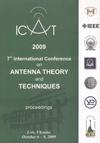The process of recovery of cell membrane damage produced by the lowlevel microwave radiation
DOI:
https://doi.org/10.1109/ICATT.2009.4435202Keywords:
cell membrane, buccal epithelium, microwave irradiation, cell recoveryAbstract
The process of cell membrane recovery after the influence of microwave radiation (f = 36.64 GHz, E = 10, 100, 400 μW/cm2, irradiation time 10 s) on human buccal epithelium cells was investigated. The stainability of cells with indigo carmine (5 mM) or trypan blue (0.5%) after 5 min of staining was investigated. It was shown irradiation to be induced decrease of percentage of unstained cells. Recovery of cell membrane permeability after microwave irradiation was shown. Cell recovery after microwave irradiation of low intensity (10 μW/cm2) was shown after 1 h. Microwave irradiation of higher intensity (100, 400 μW/cm2) induced more strongly effects of cell membrane permeability. Cell recovery after microwave irradiation of higher intensity was shown after 3 h. For the first time recovery of cell membrane after microwave irradiation of low intensity was shown.References
SHCKORBATOV, Y.G.; SHAKHBAZOV, V.G.; NAVROTSKAYA, V.V.; ZHURAVLEVA, L.A.; GRABINA, V.A.; SIRENKO, S.P.; FISUN, A.I.; GOROBETS, N.N.; KIYKO, V.I. Electrokinetic properties of nuclei and membrane permeability in human buccal epithelium cells influenced by the low-level microwave radiation. Electrophoresis, 2002, v.13, p.2074-2079.
SHTEMLER, V.M. Changes in the transport of K+ and Na+ in human erythrocytes under the influence of microwaves. Occupational Hygiene and Effects of Electromagnetic Waves of Radio Frequencies. Moscow: Medicine, 1972, p.62-68 [in Russian].
ZALYUBOSVKAYA, N.P.; KISELEV, R.I.; TOVSTYAK, V.V. Effect of the microwaves on the membranes of the tissue culture cells. Works of Institute of Cytology, 1977, n.17, p.38-39.
KAZBEKOV, E.N.; VYACHESLAVOV, L.D. Effects of microwave irradiation on some membrane-related processes in bacteria. General Physiology and Biophysics ChSSR, 1987, n.6, p.57-64.
ALEKSEEV, S.I.; ZISKIN, M.C. Millimeter microwave effect on ion transport across lipid bilayer membranes. Bioelectromagnetics, 1995, n.16, p.124-131.
GELETYUK, V.I.; KAZACHENKO, V.N.; CHEMERIS, N.K.; FESENKO, E.E. Dual effects of microwaves on single Ca2+-activated K+ channels in cultured kidney cells. FEBS Letter, 1995, n.359, p.85-88.<
TSONG, T.Y. Molecular recognition and processing of periodic signals in cells: study of activation of membrane ATPases by alternating electric fields. Biochimica et Biophysica Acta, 1992, n.1113, p.53-70.
PANAGOPOULOS, D.J.; KARABARBOUNIS, A.; MARGARITIS, L.H. Mechanism for action of electromagnetic fields on cells. Biochemical and Biophysical Research Communication, 2002, n.298, p.95-102.
NASSONOV, D.N. Uber den Einfluss des Oxidationsprocesse auf die Verteilung von Vitalfarbs toffen in Zelle. Ztschr Zellforsch mikrosk Anat., 1930, B.11, S.179-217.
SHCKORBATOV, Y.G.; PASIUGA, V.N.; KOLCHIGIN, N.N.; BATRAKOV, D.O.; KAZANSKY, O.V.; KALASHNKOV, V.V. Changes in the human nuclear chromatin induced by ultra wideband pulse irradiation. Central European Journal of Biology, 2009, v.4, n.1, p.97-106.

